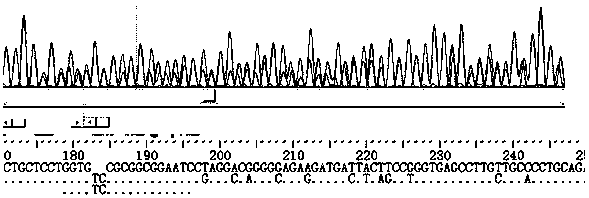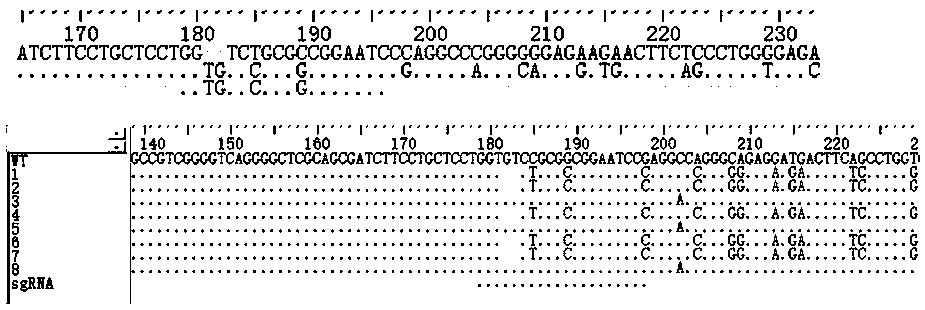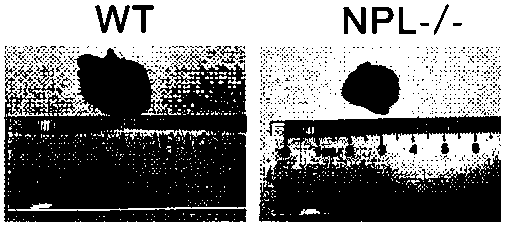Construction method for sialidase gene knockout mouse model and application thereof
A gene knockout mouse and sialidase technology, applied in the field of gene editing, can solve the problems of large randomness and low efficiency of integration, and achieve the effects of short experiment period, saving experiment cost, and direct and significant effect
- Summary
- Abstract
- Description
- Claims
- Application Information
AI Technical Summary
Problems solved by technology
Method used
Image
Examples
Embodiment 1
[0037] Example 1 Construction of Recombinant NPL Knockout CRISPR System Plasmid
[0038] (1) Design of sgRNA
[0039] First, find the genome sequence of the mouse NPL gene through NCBI, and design the sgRNA targeting the NPL gene (sequence is GGTGTCCGCGGCGGAATCCG) on the sgRNA design website of Zhang Feng’s research group http: / / crispr.mit.edu / , and reverse complementation to obtain the reverse strand sequence. Residues after digestion of the BbsI restriction site were added to both ends, and synthesized.
[0040] The two fragments after synthesis are as follows:
[0041] F: CACCG GGTGTCCGCGGCGGAATCCG;
[0042] R: AAAC CGGATTCCGCCGCGGACACC C;
[0043] (2) sgRNA annealing,
[0044] Annealing reaction system:
[0045]
[0046] Mix the prepared liquid evenly, centrifuge briefly and place in a gradient PCR instrument, run the program: 95°C, 10min; 85°C-65°C decreases by 0.1°C per second, 25°C, to form a double-stranded oligonucleotide;
[0047] Positive strand F: CACCGGG...
Embodiment 2
[0061] Example 2 Verification of the knockout vector at the cellular level
[0062] Before using the CRISPR system to knock out the vector for the preparation of knockout mice, it is necessary to verify whether the designed sgRNA is effective, and the knockout verification can be performed in the mouse cell line. Proceed as follows:
[0063] cell transfection
[0064] 1) Take the cells in the logarithmic growth phase and inoculate them in a six-well plate. Establish the experimental group and the control group, and wait for the cell plating rate to reach 75-80%.
[0065] 2) Take two EP tubes, add MEM (50 μl) + lipo3000 (3.75 μl) to tube I, add MEM (50 μl) + DNA (2.5 μg) + P3000 (5 μl) to tube II.
[0066] 3) Add the liquid in II to I, mix well and let it stand for 5 minutes, then add it to a six-well plate and culture it in a cell culture incubator.
[0067] Genome Extraction and Validation
[0068] Primers were designed to amplify about 300 bp at the upper and lower ends...
Embodiment 3
[0075] Fertilized egg retrieval
[0076] (1) Egg donor female mice were intraperitoneally injected with 0.1ml (5U) of pregnant horse serum gonadotropin PMSG, thereby promoting the maturation of female mice's eggs.
[0077] (2) After the injection, the recipient female mouse and the ligated male mouse were caged together, and they were placed in a pseudo-pregnant state through normal mating;
[0078] (3) After pseudopregnancy, female mice were injected with human chorionic gonadotropin hCG 0.1ml (5U), and then mated with normal male mice at a ratio of 1:1.
[0079] (4) On the second day, the donor mice and recipient mice were checked for pregnancy plugs, and the mice with pregnancy plugs were used for fertilized egg collection.
[0080] The specific operation of microinjection is as follows:
[0081] (1) Use the egg transfer device to absorb the fertilized egg cells and place them in the M2 medium on the glass slide;
[0082] (2) Absorb and fix the prepared fertilized eggs w...
PUM
 Login to View More
Login to View More Abstract
Description
Claims
Application Information
 Login to View More
Login to View More - R&D
- Intellectual Property
- Life Sciences
- Materials
- Tech Scout
- Unparalleled Data Quality
- Higher Quality Content
- 60% Fewer Hallucinations
Browse by: Latest US Patents, China's latest patents, Technical Efficacy Thesaurus, Application Domain, Technology Topic, Popular Technical Reports.
© 2025 PatSnap. All rights reserved.Legal|Privacy policy|Modern Slavery Act Transparency Statement|Sitemap|About US| Contact US: help@patsnap.com



